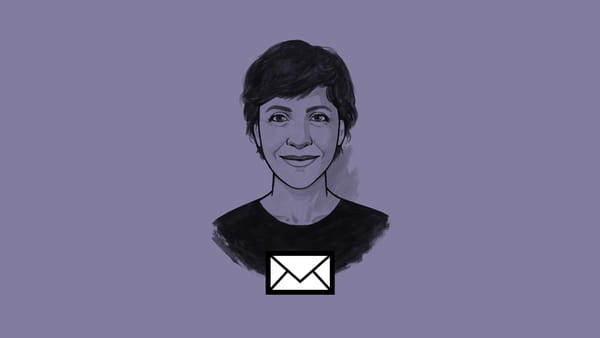Hi,
Last week the peace and quiet of my parents’ well-curated rooftop terrace, which includes a collection of cacti they picked up all over the Americas and repotted here in Naples, was disturbed by workers refurbishing the building next door.
My parents were horrified as the builders had to rip off the bougainvillea from the wall, where they had been growing and flourishing for the past 20 years. But Lorenzo, my 15-month-old son, was happier than in a playground.
All of a sudden, the plants were all chaotically jumbled together, there was a ladder in the middle of the place, and rubble all over. He jumped from one spot to another picking up little stones and soil, and mixing them in his hands. He found a puddle of water and added that to the mix. To his surprise, mud appeared on his hands, and he examined its consistency in awe before swiftly cleaning it off on his onesie and moving on to pick up a piece of plastic.
What to my parents was chaos that interrupted their sense of a structured home, for Lorenzo seemed an opportunity to play in a magical land of colours, textures and elements.
But how can such different visions of home live together peacefully under the same roof?
I examine this in the piece I published today – you can read it here.
My main takeaway is that we adults need to understand space from children’s perspectives if we want to avoid unnecessary stress. After all, “play is a disposition as well as an activity”, as Sudeshna Chatterjee, an urbanist and global expert on children’s environments and child-friendly cities, based in New Delhi, told me. You can read more of Sudeshna’s thoughts, and some of her tips, below my article today!
The importance of thinking long-term
Before joining The Correspondent, I was a freelance reporter for 15 years, mainly around Latin America.
Freelancing is fun and adventurous. Mostly you don’t have to show up at the office every morning, you can work from wherever you like, and you have the perfect excuse to try out things you are into (think prize-winning chocolate, skydiving, or climbing active volcanoes).
It also means: no paid holidays, no sick pay, no long-term planning. How can you plan stories ahead of time if your editor may leave, or change their ideas, or you may have to pick up some better-paid job along the way?
Despite this, I tried to carve out some expertise throughout the years, attempting to follow the things I was passionate about. I reported on children, women, and gender inequality in football, for example.
But mostly it was thanks to external support, like a grant, or through ingenious ways I found of spending very little money (eg housesitting instead of paying rent).
I’m telling you all of this because I feel there is no better illustration to explain what short-term thinking does to journalism. I had to jump from one story to another, following what was in the news and what I thought may catch the attention of editors and readers. It gave me less time to dig deep, go beyond the headlines, follow my instincts and write about the more foundational.
Renew your membership, please
These are all things we aim for at The Correspondent. We are funded by members, which means that you, our readers, pay for my salary (among many other things) and give me the opportunity to plan long-term, alongside my colleagues.
Your long-term backing allows me to think about the topics I want to tackle throughout 2020, as I wrote about here. (Looking at the list now, it feels like I need at least until 2022 to cover them all!)
It also allows me to listen to your suggestions and chase them up.
This is why we’re asking members of The Correspondent to renew their membership now. If we know that you will stick around for another year, we can plan our future better and come up with more meaningful journalism.
So, if you’re a member, click here to make sure you have renewed your membership. (And many many thanks if you have already renewed!)
If you’re not a member but like these newsletters and the other work I do for The Correspondent, consider signing up to our sneak peek: it’s a good way to try out our journalism before paying for it.
Black Lives Matter
At a time when structural racism is again making headlines following the police killing of George Floyd, an unarmed black man, I’ve been thinking about Floyd’s two daughters.
We may use the same words to refer to fathers, mothers and children, but parenthood is far from a universal experience when racism makes our lives worth more or less, according to our skin colour.
“I fear the day my 4-year-old son will stop being ‘so cute’ and become ‘so scary’. I’m terrified that my daughter or I will be the next Black woman or girl killed in what should be the safety of our home. And so I pretend that everything is fine and deal with my stress-induced muscle spasms silently,” writes A. Rochaun Meadows-Fernandez in this piercing essay about her fears and trauma as a black mother in the US.
I am a white woman, with a white child, and I’m far from Meadows-Fernandez’s experience. But in the coming weeks I want to amplify voices of black parenthood. So, please share your reads and videos with me so that I can learn more, and share further.
Until next week,
Irene
P.S. In last week’s newsletter I wrote about the paediatrician who told me I was damaging my son by breastfeeding him. Thanks to those of you who wrote in and shared stories and anecdotes. I felt your warmth. Breastfeeding is a complex subject and I’m already planning my next piece on it. So, stay tuned!
 Would you like this newsletter straight in your inbox?
Subscribe to my weekly newsletter where I talk about sexuality, reproductive rights and early childhood, discuss the best ideas from members and share updates on my journalism.
Would you like this newsletter straight in your inbox?
Subscribe to my weekly newsletter where I talk about sexuality, reproductive rights and early childhood, discuss the best ideas from members and share updates on my journalism.

